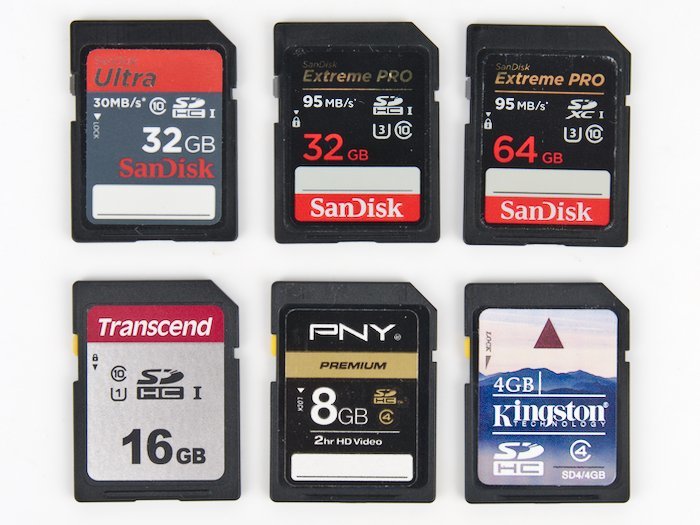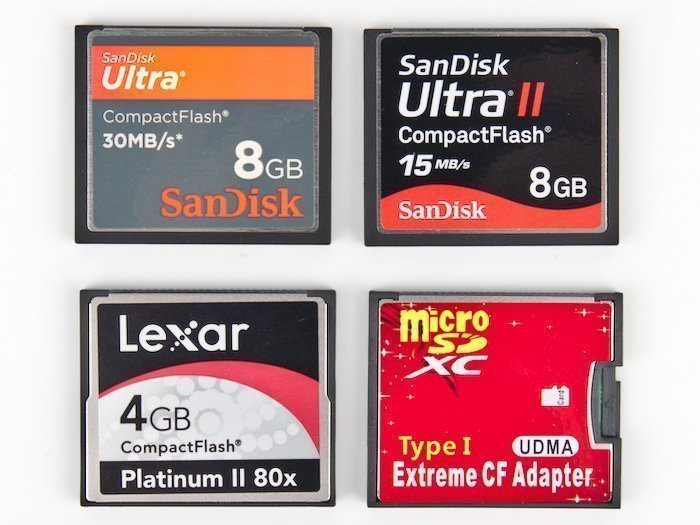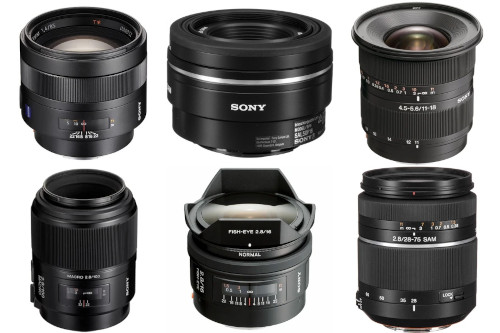
The 6 Best Lenses for the Sony A100
- Nathaniel Stephan
- Sony a100
- April 10, 2020
Table of Contents
As a Sony DSLR-A100 user, one can look forward to a plethora of lens options designed for this specific camera model, with the expansive Sony or Konica Minolta A-mount system at their disposal.
The Sony Alpha DSLR-A100, a camera renowned for its solid performance and robust features, was designed to take full advantage of this diverse lens ecosystem. These lenses range from super-wide angle to super-telephoto, with a variety of fixed focal length (prime) and zoom options available, allowing users to capture everything from sprawling landscapes to minute details in stunning quality.
It’s worth noting that the A-mount system also includes lenses from brands like Sigma and Tamron, offering alternatives with different strengths and price points.
When it comes to quality, Sony and Konica Minolta A-mount lenses are well-regarded for their solid build, optical performance, and technological features, including advanced autofocus capabilities and image stabilization systems. These lenses are typically crafted from high-quality materials, ensuring durability and longevity while delivering exceptional image clarity, sharpness, and color rendition.
The selection of lenses is one of the strong points of the Sony DSLR-A100, with a range of lenses to suit various shooting styles and photographic requirements. Whether you’re an enthusiastic beginner, a dedicated hobbyist, or a professional photographer, there’s likely a lens within the A-mount system that meets your specific needs and budget. From versatile standard zoom lenses for everyday use, to bright prime lenses for low light photography and portraiture, to macro lenses for capturing tiny details, you’re spoiled for choice when it comes to Sony A100 lenses.
Affiliate Advertising Disclosure
Outside the Shot is a participant in the Amazon Services LLC Associates Program, an affiliate advertising program designed to provide a means for sites to earn advertising fees by advertising and linking to Amazon.com.
As an eBay Partner, I may be compensated if you make a purchase. I also participate in affiliate advertising programs with KEH and Adorama. More can be found on the Affiliate Disclosure page.
More information is down further, however if you’re in a hurry, below are the best selections:
- Standard Lens - Sony 50mm f/1.8 SAM DT
- Portrait Lens - Sony 85mm F1.4 ZA CZ
- Zoom Lens - Sony 28-75mm f/2.8
- Wide Angle Lens - Sony DT 11-18mm f/4.5-5.6
- Fisheye Lens - Sony 16mm f/2.8
- Macro Lens - Sony 100mm f/2.8 Macro
Below, the best Sony lenses are separated by type of photography. There are different selections varying in cost.
Standard Primes
Sony 50mm f/1.8 SAM DT
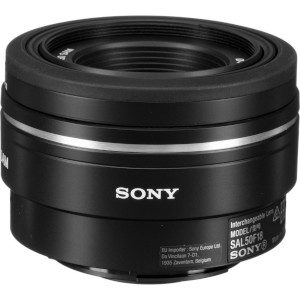
- Outstanding optics.
- Small and light weight.
- Can be difficult to find new.
- Smooth Autofocus Motor (SAM)
- Circular aperture.
See current price and more information on:
A terrific combination of very compact size and lightweight. Fast and quiet autofocus is delivered by a built-in motor..
The circular aperture allows you to stop down by 2-stops and still have an almost circular aperture. This delivers gorgeous bokeh and greater versatility in managing your depth of field.
Minolta Maxxum AF 50mm f/1.7
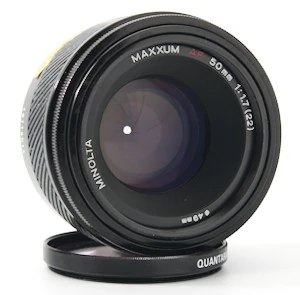
- Built-in lens hood.
- Amazing value.
- Light and compact.
- Widely available used.
- Coupled autofocus.
See current price and more information on:
This is one of the first lenses from the intro of the A-mount for autofocus. Due to the age of the lens, the autofocus is driven by the motor built into the A100’s body.
Coupled autofocus can be noticeably noisy and jerky. If that is not a major problem for you the image quality is amazing. {The bokeh is attractive and you will end up with a classic look to your images|You’ll get a classic image rendering and eye-catching bokeh.
One more significant benefit of this lens is the price. It’s significantly cheaper when compared to the Sony 50mm f/1.8 and on top of that could be the least expensive lens on the list.
Sony 50mm f/1.4
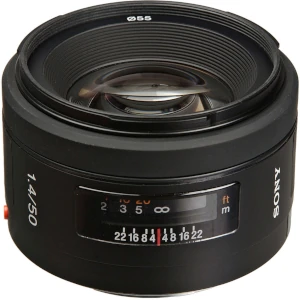
- Outstanding optics.
- Optical multi-coatings.
- Circular aperture.
- 55mm filter threads.
See current price and more information on:
A bit faster when compared to the Sony f/1.8, but that can definitely be important when you are taking pictures in low light. That not surprisingly comes at an additional expense.
It is still a light and relatively small lens that works well on the A100 and will fit into virtually any camera bag.
A possibly less expensive alternative is the Minolta AF 50mm f/1.4. Be aware that they can be difficult to come across in usable condition. It also was built with physically coupled autofocus, which is worse than lenses that have built-in autofocus motors}.
Portrait & Telephoto Lens
Sony 85mm f/1.4 ZA
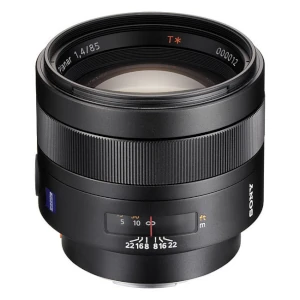
- Incredible bokeh.
- Excellent value used.
- T* coating to reduce flare and increase contrast.
- Astonishingly sharp wide open.
See current price and more information on:
Sony wanted to exhibit what the A-mount can do. Zeiss produced this lens. The ZA (Zeiss Alpha) indicates that Zeiss created the lens specifically for the A-mount.
This lens is the real deal. Corner-to-corner sharpness with brilliant color that produces amazing portraits.
Potential downsides are that it’s a little on the heavy side due to being built like a tank and the autofocus can feel slow. Be aware, that you will find those same issues with any f/1.4 85mm.
Minolta Maxxum AF 85mm f/1.4
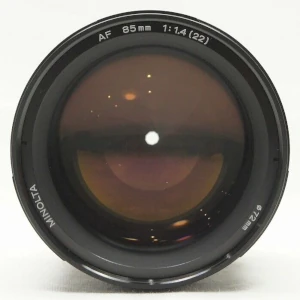
- Possible to find a good used deal.
- Superb image quality.
- Uses autofocus coupler.
- Double-Gauss design.
See current price and more information on:
In terms of price, this lens sits between the others. Finding a used copy in better than acceptable condition could be hard as a result of a small available supply.
The lens does have autofocus, but it uses a mechanical coupler and is driven by an in-camera body motor. This means the lens will be a bit loud and slow to autofocus.
The lens is an older 6 lens element Double-Gauss design. That’s not a negative as the lens has a distinctive appearance that is not able to be produced using a modern lens.
Sony A100 Zoom Lenses
Sony 28-75mm f/2.8
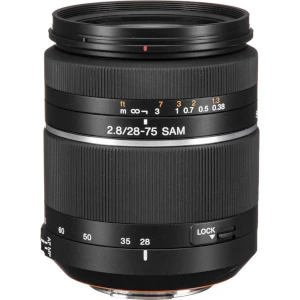
- Very usable zoom range.
- Great value used.
- Constant aperture.
- Smooth Autofocus Motor (SAM).
See current price and more information on:
A fast zoom lens that is perfect for night events, travel, indoor shooting, and family photos. The autofocus is fairly quiet and the lens is well constructed.
The lens is often compared to the legendary Zeiss 24-70mm, but it’s approximately 1/2 the weight and costs considerbly less. Both lenses produce pro images.
Sony 55-200mm f/4-5.6 SAM DT
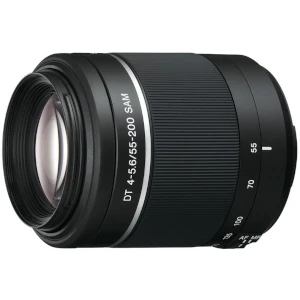
- Telephoto zoom range.
- Great for portrait or wildlife photography.
- Smooth Autofocus Motor (SAM).
- Inexpensive.
See current price and more information on:
While still creating very good results, this is a less expensive choice. It’s not a pro lens, consequently assuming that you do not require high end technology, it is an excellent lens.
For a telephoto zoom, it has an outstanding range for shooting pictures of sports, children outdoors, and wildlife.
The autofocus is snappy and it renders razor-sharp pictures. The lens is constructed of plastic, which aids in eliminating weight.
Sony 75-300mm f/4.5-5.6
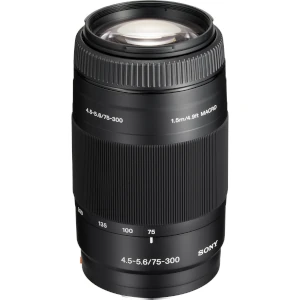
- Super telephoto zoom lens.
- Great for portrait or wildlife photography.
- 2.81 inches in diameter and 4.81 inches long.
- 55mm filter threads.
See current price and more information on:
A super-telephoto lens due to the large zoom range. It’s an excellent affordable alternative for any time you desire a lots of reach.
It’s only 4.8 inches (12.2 cm) long, 2.8 inches (7.1 cm) in diameter, and is 1 pound 2 ounces (510g). While that is not considered light, many pro telephoto zooms are multiple times heavier.
For a little bit better performance look for the Sony 70-300mm f/4.5-5.6 SSM ED G-Series, but assume you’ll have to pay nearly twice as much.
Wide Angle Lens
Sony DT 11-18mm f/4.5-5.6
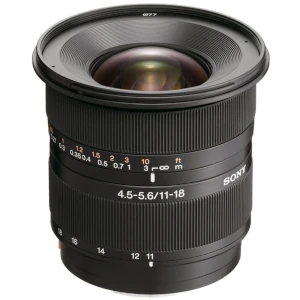
- Has a aspherical lens elements.
- Optical multi-coatings.
- Great value when purchased used.
- Circular aperture.
See current price and more information on:
Excellent value for the money if you want to shoot outstanding wide images that standard kit zooms can’t capture. Distortion, especially of vertical lines is low or non-existent unless you are purposefully trying to have an exaggerated perspective.
In addition to being outstanding at capturing beautiful landscapes, it’s an excellent lens to travel with. The lens is wide enough so that when you come across something you’ll be able to get everything in frame.
Sony 20mm f/2.8
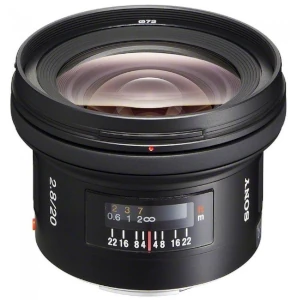
- Great for landscapes and architecture.
- Coated optics for clarity and definition.
- Rear focusing system for fast autofocus response.
- 72mm filter threads.
See current price and more information on:
It’s well-corrected and does an excellent job of reducing lens distortion. Additionally, quite a lot of effort has been done to minimize internal reflections and flare.
The result is an outstanding lens that is appropriate for astrophotography, architecture, and landscape photography. The rear focusing system means the front element is not going to rotate so you will not have any troubles using a circular polarizer or another filter.
Tokina AT-X 11-16mm f/2.8 DX II
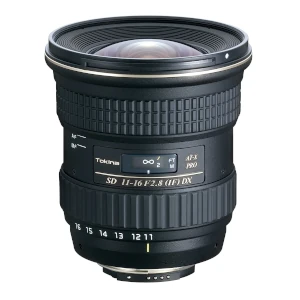
- Wide angle zoom lens.
- Hardened Alumite finish.
- Advanced optical coatings.
- All metallic moving parts.
- Designed for APS-C image sensors.
See current price and more information on:
It does not have extremely fast autofocus, but the MF/AF focus clutch means it’s a great pick for manual focusing. A pull or push of the focus ring will switch the lens from AF to MF or vice versa.
The Tokina has a larger aperture when compared to the Sony 11-18mm, which is not a huge issue for landscape or architecture photography. Where you’ll observe a big difference is with astrophotography. That’s a situation where you’d want to have the 1-to-2 stop advantage the Tokina offers you.
Fisheye
Sony 16mm f/2.8 Fisheye
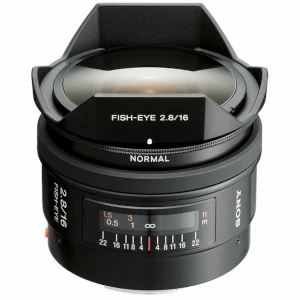
- Sharp corner-to-corner.
- 4 built-in filters: Normal, 056, B12, A12.
- 8 inch minimum focus distance.
- Aspherical and Extra-low Dispersion elements.
See current price and more information on:
Having built-in filters is a fantastic addition due to the fact the lens has a petal-style hood which prevents a lens filter from being attached to the front of the lens.
- 056 - Accented contrast for black and white photos.
- B12 - Correct color by eliminating red tones.
- A12 - Correct color by eliminating blue tones.
This lens has pretty much everything you could require from a fisheye lens. You can get the exaggerated distortion, but the image will be sharp from corner-to-corner without vignetting.
Rokinon 8mm f/3.5 Fisheye
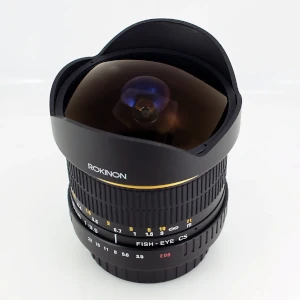
- Internal focus.
- 180 degree angle of view.
- Manual focus.
- Minimum focusing distance of 12 inches (0.3m).
- Designed for APS-C sensors.
See current price and more information on:
The lens contains a large front that means lens filters can not be attached. It has a snap-on petal-style lens hood that you will want to make sure is included if you buy a used copy.
Construction quality will be a little hit or miss due to the budget price. Almost all owners are quite happy with the results they get. You will nevertheless want to fully test out the lens when you receive it to make sure the lens is not a bad copy.
Macro Lens
Sony 100mm f/2.8 Macro
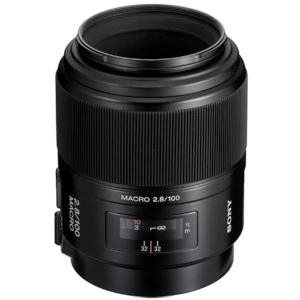
- 9 aperture blades.
- Focus range limiter.
- High contrast and resolution.
- 55mm filter threads.
See current price and more information on:
The right balance of price, size, and working distance for the Sony Alpha A100. The autofocus can be somewhat noisy, but for taking macro images, manual focus is easier than using autofocus.
For the optimal images at 1x magnification the lens really needs to be stopped down. Doing that will additionally give you a larger depth of field, which is useful for macro photography.
Sony 50mm f/2.8 Macro
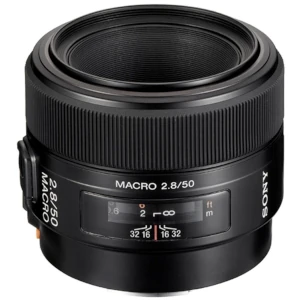
- 10.4 ounces (295g).
- Focus range limiter.
- Focus Hold button for full creative control.
- 55mm filter threads.
See current price and more information on:
A 50mm isn’t ideal for 1x magnification as a result of how little working distance you will have. At that level of magnification, the front lens element will need to be about 2 inches (5 cm) from the subject.
This lens excels at close-up, copy work, and tabletop photography. It gives you the option to get closer to a subject than a standard 50mm lens, and that is ideal for nature photography if you want to fill the camera frame with a smaller sized subject, such as a flower.
Tamron AF 90mm f/2.8 Di SP A/M 1:1 Macro
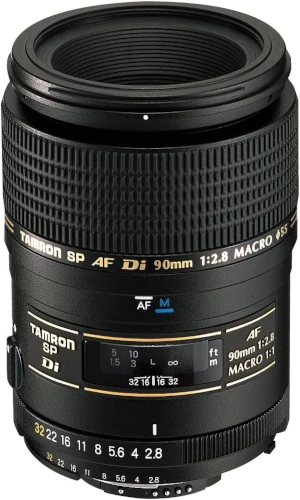
- Available in a variety of camera mounts.
- Improved resolution, chromatic correction, and optical coatings.
- Super Performance (SP)
- Focus clutch to switch between AF & MF.
See current price and more information on:
In addition to having autofocus, the focus ring feels great when manually focusing. Closed down a couple of stops and you will get razor-sharp photos.
Additionally, be cautious when buying this lens as it is manufactured for various lens mounts.
Shooting Modes on the Sony Alpha A100
The Sony A100 boasts a range of shooting modes that give photographers flexibility and control over their image creation process. They can be selected by using the function dial. These modes are designed to facilitate various types of photography, ensuring that users can adapt to different shooting conditions and photographic requirements.
Here’s a summary of the main shooting modes available on the Sony DSLR-A100:
- Auto Mode: This is the point-and-shoot mode, where the camera automatically adjusts all settings according to the shooting conditions.
- Program Mode (P): In this mode, the camera automatically sets the aperture and shutter speed, but allows the user to control other settings such as ISO, white balance, and flash.
- Aperture Priority Mode (A): This mode lets the user set the aperture value manually, while the camera adjusts the shutter speed accordingly to achieve the correct exposure.
- Shutter Priority Mode (S): In this mode, the user manually sets the shutter speed, while the camera adjusts the aperture accordingly.
- Manual Mode (M): This mode gives the user full manual control over all settings, including aperture, shutter speed, and ISO.
- Portrait Mode: This mode optimizes settings for shooting portraits, often providing a soft background blur to make the subject stand out.
- Landscape Mode: This mode sets the camera to capture the depth and detail in landscape scenes, often with a small aperture for a larger depth of field.
- Macro Mode: This mode is ideal for close-up shots, optimizing settings for capturing fine details of small subjects.
- Sports Mode: This metering mode uses a faster shutter speed to freeze the action in fast-paced scenarios.
- Night Scene Mode: This mode is designed for shooting in low light conditions, often using longer shutter speeds and higher ISO settings.
By understanding and effectively utilizing these shooting modes, photographers can unlock the full potential of the Sony DSLR-A100, achieving optimal results in a wide range of shooting conditions and scenarios.
Used A-Mount Camera Lens Prices
Pricing is constantly in flux. Over the past handful of years, interest in film photography has been going up. Seeing as there are Minolta 35mm cameras that use A-mount lenses, some additional demand is placed on the price of lenses.
The Sony A-mount also does not have a significant share of the market compared to other digital cameras. Due to this fact, fewer third party options exist and the lenses produced by Sony are oftentimes on backorder.
To obtain the best price on what you want, look at a few sites. For pre-owned lenses, be ready to make a purchase when you see a good deal as they generally will not last long.
What Lens Mount Does the A100 Use?
The Sony A100 uses the Sony A-mount. It’s also the same as the Konica Minolta A-mount. This is because Sony bought Konica Minolta’s imaging division in 2006.
Konica Minolta engineered the A-mount for the intro of interchangeable lens cameras with autofocus in 1985. It was used in digital cameras produced by Konica Minolta and Sony.
Standard Lens Cap Size
Generally 55mm, but really the sizes are all over the place. Older Konica Minolta lenses have 49mm filter threads.
Additionally, there are a number of lenses that have larger filter threads than 55mm. It is not uncommon to see 77mm ro 72mm. It would’ve been nice if Sony used only 2 or 3 different filter sizes.
